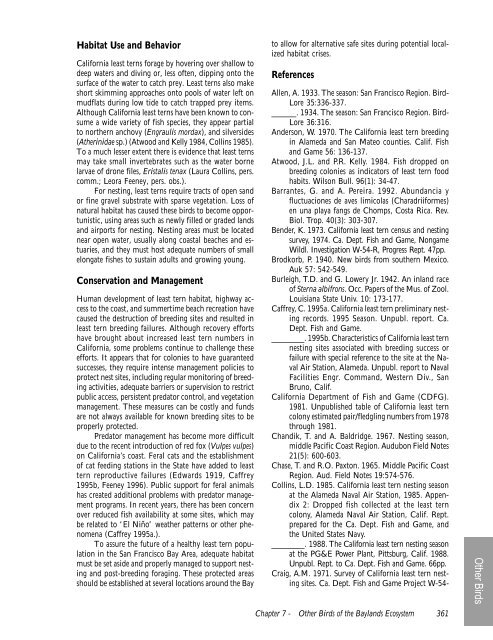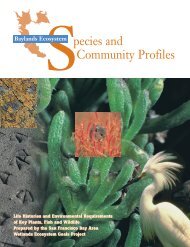Species and Community Profiles - San Francisco Estuary ...
Species and Community Profiles - San Francisco Estuary ...
Species and Community Profiles - San Francisco Estuary ...
You also want an ePaper? Increase the reach of your titles
YUMPU automatically turns print PDFs into web optimized ePapers that Google loves.
Habitat Use <strong>and</strong> Behavior<br />
California least terns forage by hovering over shallow to<br />
deep waters <strong>and</strong> diving or, less often, dipping onto the<br />
surface of the water to catch prey. Least terns also make<br />
short skimming approaches onto pools of water left on<br />
mudflats during low tide to catch trapped prey items.<br />
Although California least terns have been known to consume<br />
a wide variety of fish species, they appear partial<br />
to northern anchovy (Engraulis mordax), <strong>and</strong> silversides<br />
(Atherinidae sp.) (Atwood <strong>and</strong> Kelly 1984, Collins 1985).<br />
To a much lesser extent there is evidence that least terns<br />
may take small invertebrates such as the water borne<br />
larvae of drone files, Eristalis tenax (Laura Collins, pers.<br />
comm.; Leora Feeney, pers. obs.).<br />
For nesting, least terns require tracts of open s<strong>and</strong><br />
or fine gravel substrate with sparse vegetation. Loss of<br />
natural habitat has caused these birds to become opportunistic,<br />
using areas such as newly filled or graded l<strong>and</strong>s<br />
<strong>and</strong> airports for nesting. Nesting areas must be located<br />
near open water, usually along coastal beaches <strong>and</strong> estuaries,<br />
<strong>and</strong> they must host adequate numbers of small<br />
elongate fishes to sustain adults <strong>and</strong> growing young.<br />
Conservation <strong>and</strong> Management<br />
Human development of least tern habitat, highway access<br />
to the coast, <strong>and</strong> summertime beach recreation have<br />
caused the destruction of breeding sites <strong>and</strong> resulted in<br />
least tern breeding failures. Although recovery efforts<br />
have brought about increased least tern numbers in<br />
California, some problems continue to challenge these<br />
efforts. It appears that for colonies to have guaranteed<br />
successes, they require intense management policies to<br />
protect nest sites, including regular monitoring of breeding<br />
activities, adequate barriers or supervision to restrict<br />
public access, persistent predator control, <strong>and</strong> vegetation<br />
management. These measures can be costly <strong>and</strong> funds<br />
are not always available for known breeding sites to be<br />
properly protected.<br />
Predator management has become more difficult<br />
due to the recent introduction of red fox (Vulpes vulpes)<br />
on California’s coast. Feral cats <strong>and</strong> the establishment<br />
of cat feeding stations in the State have added to least<br />
tern reproductive failures (Edwards 1919, Caffrey<br />
1995b, Feeney 1996). Public support for feral animals<br />
has created additional problems with predator management<br />
programs. In recent years, there has been concern<br />
over reduced fish availability at some sites, which may<br />
be related to “ El Niño” weather patterns or other phenomena<br />
(Caffrey 1995a.).<br />
To assure the future of a healthy least tern population<br />
in the <strong>San</strong> <strong>Francisco</strong> Bay Area, adequate habitat<br />
must be set aside <strong>and</strong> properly managed to support nesting<br />
<strong>and</strong> post-breeding foraging. These protected areas<br />
should be established at several locations around the Bay<br />
to allow for alternative safe sites during potential localized<br />
habitat crises.<br />
References<br />
Allen, A. 1933. The season: <strong>San</strong> <strong>Francisco</strong> Region. Bird-<br />
Lore 35:336-337.<br />
______. 1934. The season: <strong>San</strong> <strong>Francisco</strong> Region. Bird-<br />
Lore 36:316.<br />
Anderson, W. 1970. The California least tern breeding<br />
in Alameda <strong>and</strong> <strong>San</strong> Mateo counties. Calif. Fish<br />
<strong>and</strong> Game 56: 136-137.<br />
Atwood, J.L. <strong>and</strong> P.R. Kelly. 1984. Fish dropped on<br />
breeding colonies as indicators of least tern food<br />
habits. Wilson Bull. 96(1): 34-47.<br />
Barrantes, G. <strong>and</strong> A. Pereira. 1992. Abundancia y<br />
fluctuaciones de aves limicolas (Charadriiformes)<br />
en una playa fangs de Chomps, Costa Rica. Rev.<br />
Biol. Trop. 40(3): 303-307.<br />
Bender, K. 1973. California least tern census <strong>and</strong> nesting<br />
survey, 1974. Ca. Dept. Fish <strong>and</strong> Game, Nongame<br />
Wildl. Investigation W-54-R, Progress Rept. 47pp.<br />
Brodkorb, P. 1940. New birds from southern Mexico.<br />
Auk 57: 542-549.<br />
Burleigh, T.D. <strong>and</strong> G. Lowery Jr. 1942. An inl<strong>and</strong> race<br />
of Sterna albifrons. Occ. Papers of the Mus. of Zool.<br />
Louisiana State Univ. 10: 173-177.<br />
Caffrey, C. 1995a. California least tern preliminary nesting<br />
records. 1995 Season. Unpubl. report. Ca.<br />
Dept. Fish <strong>and</strong> Game.<br />
________. 1995b. Characteristics of California least tern<br />
nesting sites associated with breeding success or<br />
failure with special reference to the site at the Naval<br />
Air Station, Alameda. Unpubl. report to Naval<br />
Facilities Engr. Comm<strong>and</strong>, Western Div., <strong>San</strong><br />
Bruno, Calif.<br />
California Department of Fish <strong>and</strong> Game (CDFG).<br />
1981. Unpublished table of California least tern<br />
colony estimated pair/fledgling numbers from 1978<br />
through 1981.<br />
Ch<strong>and</strong>ik, T. <strong>and</strong> A. Baldridge. 1967. Nesting season,<br />
middle Pacific Coast Region. Audubon Field Notes<br />
21(5): 600-603.<br />
Chase, T. <strong>and</strong> R.O. Paxton. 1965. Middle Pacific Coast<br />
Region. Aud. Field Notes 19:574-576.<br />
Collins, L.D. 1985. California least tern nesting season<br />
at the Alameda Naval Air Station, 1985. Appendix<br />
2: Dropped fish collected at the least tern<br />
colony, Alameda Naval Air Station, Calif. Rept.<br />
prepared for the Ca. Dept. Fish <strong>and</strong> Game, <strong>and</strong><br />
the United States Navy.<br />
________. 1988. The California least tern nesting season<br />
at the PG&E Power Plant, Pittsburg, Calif. 1988.<br />
Unpubl. Rept. to Ca. Dept. Fish <strong>and</strong> Game. 66pp.<br />
Craig, A.M. 1971. Survey of California least tern nesting<br />
sites. Ca. Dept. Fish <strong>and</strong> Game Project W-54-<br />
Chapter 7 — Other Birds of the Bayl<strong>and</strong>s Ecosystem 361<br />
Other Birds



